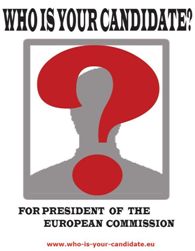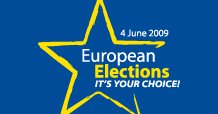Paradoxically, the turnout in European elections has been decreasing ever since the first direct elections in 1979 while the power of the European Parliament has been steadily increasing. More and more laws are made by the ‘citizen’s chamber’ while less and less people take advantage of their right to directly influence these decisions.
It’s all about choice
This year, there will be no lectures about citizen’s responsibilities or duties in the European Parliament’s communication strategy - the European elections 2009 are all about choice. The key message is that all citizens can influence policies by giving their vote. This message is spread with a single campaign throughout Europe: Postcards, billboards and 3-dimensional street installations will raise important questions concerning energy, climate change, agriculture, consumer protection, security, free markets and other important topics. In room-sized cubes with the name “choice boxes”, citizens can record their views on European issues – selected scenes will be played on Europarl TV, Youtube and on screens outside the boxes. In order to reach all potential voters, the campaign will also be present on TV and radio, young voters are supposed to be attracted by My Space, Facebook and Flickr.
So far so good. In times of crises, with important challenges ahead, it is important to convince European citizens to take advantage of their right to vote. It is very pleasing that for once the European Parliament and the European Commission are using a single campaign throughout Europe raising questions that definitely need to be discussed on a European level. But to which extend is this campaign a European one and how much choice do voters really have?
“Choosing” the pig in the poke
It is true that the European Union is facing important challenges in the fields of economics, finances, environment and society that demand common action. The main argument of the European Parliament election campaign is that by voting for one party or another, citizens can influence the choices made in the next period of legislation. However, voting in the elections to the European Parliament is still a bit like buying a pig in a poke. Voters opt for national political parties that form part of European parties. On the ballot, there is no hint as to which European party this will be. Unless he actively informs himself before the elections, a Danish voter will not be able to tell that the Farmer’s party he gives his vote to will be part of the Group of the Liberals and Democrats in the European Parliament. True, he had the choice. But was it really his intention to support the Liberals on the European level?
If the European Parliament offers choices, it would be important to clarify what these choices really consists of and what they result in. Presenting the names and logos of the Groups of European parties on the ballot would be a first step in the right direction. It would, however, change nothing about the fact that European parties are very heterogeneous due to their composition of various national parties. The only way to actually know what the parties stand for, the only way to really make a choice, is to vote for Paneuropean parties with transnational lists, allowing citizens to elect candidates from all over Europe, regardless of their nationality.

Barroso, Barroso or Barroso?
It starts with the names of the European Parties, it continues with the faces of the candidates to the most important positions in the European Union. What do we really choose? Who do we elect by giving our vote to one party or another? In principal, it would be possible for European citizens to elect the executive of Europe, the European Commission, with their vote for a party. Right after the elections to the European Parliament, the next President of the Commission will be appointed. The ‘citizen’s chamber’ has the final say on who this will be. It would make absolute sense and be very democratic if the candidate of the strongest party or coalition would become President of the Commission. This way, voters could influence the composition of the Commission and hold it to account - if only the European Parliament and the European Parties took their responsibility of delivering political choices seriously and nominated a candidate to this position. No party did. Names and faces of the candidates to the main political positions of the European institutions will only be presented after the election. No matter who people vote for the president of the Commission will most likely remain Barroso that has already been backed for the second term as a President of the European Commission – by the heads of states, even socialist ones like Brown and Zapatero, not by the citizens or the Parliament. So what is there to choose from? Unsurprisingly, European citizens feel that their vote does not count and that the whole EU system is not transparent. From this point of view, a campaign with the slogan “it’s your choice” sounds like a hoax. “Choosing” means that you can select from a number of alternatives. Unless the European Parties nominate their candidates to the position of the President of the Commission, the citizens “choice” will be: Barroso, Barroso or Barroso.
A single European campaign?
Moreover, the European elections are still dominated by nationality. Citizens have the “choice” from their national parties rather than from transnational party lists with candidates from all countries. As a result, discussions are limited to the national level. Raising questions like “what kind of energy do we want?”, “how much security is too much?”, or “how far should standardisation go?” is very important. However, as long as discussions do not reach across borders and parties run campaigns based mainly on national politics, these questions will not result in finding the right answers. Instead, they might well go into the next national elections – which in some countries, like Germany, are upstaging the European elections anyway. Moreover, by tailoring the campaign to the member states, the strategy adds to the tendency of debating at the national level. The posters and installations concerning borders will above all be prominent in Southern Europe. They feature a fortress and a hedge and raise the question “What kind of borders should we have?” Not only does the presentation simplify the debate to a level that impedes serious discussion, it also prevents discussions on a European level.
This way, the strategy misses the most important point: Explaining why it is so important to solve these issues at a European level and encouraging discussions that go beyond the national perspective.
One of the main campaign ideas was to speak the language people speak, the main message is choice. It is time for the European Parliament to engage its voters in real discussions. It is time to provide the basis for real choices.


Follow the comments: |
|
